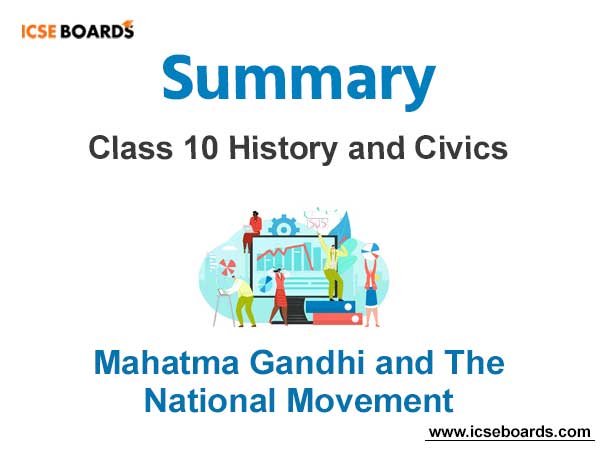Students should refer to Mahatma Gandhi and The National Movement Class 10 ICSE notes provided below which has been designed by ICSE Class 10 History teacher based on the latest syllabus and examination guidelines for ICSE Class 10 History. You should carefully read through and understand all topics of this chapter given below so that you can learn the concepts given in Chapter Mahatma Gandhi and The National Movement which will be very useful if you use them prior to your History exams.
ICSE Class 10 History Mahatma Gandhi and The National Movement Summary
We have provided below a summary of Chapter Mahatma Gandhi and The National Movement. This is an important chapter in Standard 10th ICSE History. The summary provided below has been prepared by expert History faculty for ICSE based on the latest ICSE books. You should refer to all Chapter Summaries ICSE Class 10 History which will help you to understand all chapters and to get more marks in exams.
Mahatma Gandhi and The National Movement ICSE Class 10 History
Scope of Syllabus
• Non-co-operation Movement
• Causes – Khilafat Movement, Rowlatt Act, Jallianwala Bagh tragedy
• Programme and Suspension – Chauri Chaura Incident
• Impact of the movement
• Civil Disobedience Movement
• Causes- Reaction to Simon Commission, Declaration of Poorna Swaraj
• Dandi March, Programme and impact of the movement
• Gandhi- Irwin Pact
• Second Round Table conference
INTRODUCTION
During 1917 and early 1918, Gandhiji was involved in three significant struggles –
1) Champaran Satyagraha [1917] –
Indigo Cultivators of Champaran were exploited by European Planters. Indigo Cultivators were bound by law to grow Indigo on 3/20th of their land and sell it to the British Planters at prices fixed by them. Gandhiji offered Satyagraha for safeguarding the interest of indigo cultivators in Champaran, Bihar.
2) Ahmedabad Satyagraha [1918] –
Gandhiji led the mill workers of Ahmedabad in a strike against the mill owners who refused to pay higher wages to the mill workers. Gandhiji undertook a fast and hence the mill owners had to give in to the demands of mill workers and increased their wages by 35%.
3) Kheda Satyagraha [1918] –
Crops failed in Kheda and peasants were not able to pay land revenue. Gandhiji organized the peasants to offer Satyagraha, when the government refused to forgo the land revenue. Ultimately government arrived at a settlement with the peasants.
METHODS USED BY MAHATMA GANDHI DURING HIS FREEDOM STRUGGLE
1) Non-violence [Ahimsa] – Means non-killing or avoiding injury, but for Gandhiji, it meant avoiding injury to anything by thought, word or deed.
2) Satyagraha [Satya-truth; agraha- insistence to hold fast] –
It meant to be fearless, truthful as well as peaceful, suffering willingly while refusing to submit to what is wrong.
Gandhiji’s Satyagraha movement was directed against the British system of exploitation and not the British people individually or collectively.
3) Swadeshi – It means producing necessary items in one’s own country and using them for one’s use without being dependent on imported goods. Gandhiji believed that the use of swadeshi goods would make us self-sufficient and eliminate our dependence on imported goods.
4) Mass Movement – Involvement of masses to participate in the freedom movement.
NON-CO OPERATION MOVEMENT [1920]
Non-cooperation is ‘a way of protesting in which one does not cooperate with the evil-doer.’
Causes that led to the non-cooperation movement –
1) Khilafat Movement [1919] – In the First World War Turkey was defeated and the ottoman Empire was divided. The sultan of Turkey, who was the Caliph was deprived of all authority. The Caliph was looked upon by large sections of Muslims as their religious head. Muslims were angry as they felt that weakening of Caliph’s position would adversely affect the position of the Muslims. Hence, the Muslims population in India started ‘THE KHILAFAT MOVEMENT” under the leadership of Mohammed Ali and Shaukat Ali.
The Khalifates formed a 3-point Programme-
(i) The Caliph must retain his Empire.
(ii) He must be left with sufficient territory to enable them to defend the Islamic fate.
(iii) The Arab lands [Arabia, Syria, Palestine, Iraq] must remain under the Muslim Rule.
Khilafat Day – Oct. 17, 1919 –
This movement was supported by Gandhiji as he saw this as an opportunity for uniting Hindus and Muslims.
Gandhiji was elected as president of the All-India Khilafat Conference in 1919.
By Aug. 1920, the Khilafat Non-Cooperation Movement started.
• People resigned from Government Services.
• Shops selling foreign goods were picketed.
• Students boycotted schools & Colleges
• Hartals and demonstration were held.
By the end of 1920, the Khilafat movement and the Congress Non-cooperation movement merged into one nationwide movement.
In 1921, Khilafat committee appealed to Muslims not to join the police and armed forced and not to pay taxes. This enraged the government and Ali Brothers were arrested.
2) Rowlatt Act [1991] [Justice Rowlatt] –
It was passed in March 1919. This act authorized the Government to imprison any person without trial and convict him in a court.
This act implied –
(i) Arrest of a person without warrant
(ii) In camera trial [trial in seclusion]
(iii) Restrictions on movement of individuals
(iv) Suspension of the Right of Habeas Corpus
(v) Gandhiji started Satyagraha, challenging the Government
3) Jallianwala Bagh Tragedy [1919] –
A large crowd gathered at the Jallianwala Bagh in Amritsar on April 13, 1919, to protest against the arrest of leaders like Dr. Saifuddin Kitchlu and Dr. Satya Pal. The Bagh had only one exit. General Dyer, the military commander of Amritsar surrounded the Bagh with his soldiers.
After closing the exit with his troops, he ordered them to shoot at the crowd. About thousands of innocent demonstrators were killed and many more wounded.
Objectives of the Non-Cooperation Movement –
1) To attain self-government. within the British Empire if possible and outside if necessary.
2) Annulment of the Rowlatt Act and remedying the ‘Punjab Wrong’ i.e. the British Government should express its regret on the happenings in Punjab, particularly in Amritsar.
3) Remedying the ‘Khilafat wrong’ i.e. the British should adopt a lenient attitude towards Turkey and restore the old status of the sultan of Turkey.
Programmes –
1) Boycott Programmes –
(i) Boycott of government schools, colleges and courts
(ii) Boycott of foreign goods
(iii) Surrender of titles and honorary offices
(iv) Resignation from nominated seats in local bodies
(v) Refusal to attend government functions
2) Swadeshi Programmes –
(i) Popularization of swadeshi & Khadi by reviving hand-spinning and hand-weaving.
(ii) Establishment of national schools and colleges.
(iii) Development of unity between Hindus & Muslims.
(iv) Removal of untouchability.
(v) Emancipation and upliftment of women.
Suspension of the Non-Cooperation Movement –
1) Chauri Chaura
(i) Tragedy at Chauri Chaura, a village in Gorakhpur District in UP, occurred on Feb. 5, 1922
(ii) A procession of about 3,000 peasants marched to the police station to protest against the police officer who had beaten volunteers picketing a liquor shop.
(iii) The police fired at the peasants.
(iv) The Demonstrators set the Police station on fire, killing 22 police men who were inside the police station.
(v) Gandhiji was greatly shocked at these incidents, withdrew the Non-cooperation Movement on Feb. 12, 1922.
Impact of Non- Cooperation Movement –
1) The National movement became a Mass Movement – Different sections of Indian society like peasants, workers, students, teachers, etc. participated in the movement.
2) Instilled confidence among the People – It generated a desire for freedom and inspired people to challenge the colonial rule.
3) Fostered Hindu-Muslim Unity – It fostered Hindu-Muslim Unity as seen in the merger of the Khilafat movement with this movement. Congress got an opportunity to bring the urban Muslims into the National Movement by convincing them that the Nation was equally concerned with the problems affecting them.
4) Promoted social Reforms-
a) Due to non-cooperation movement, many steps were taken to prohibit and remove untouchability
b) Many national schools and colleges were set up in different parts of the country.
c) Boycott of foreign goods led to the promotion of Indian handicrafts and industries. Khadi became the symbol of National Movement.
5) Popularized the cult of swaraj – The goal of non- cooperation movement was to attain swaraj within the British empire.
THE CIVIL DISOBEDIENCE MOVEMENT [1930]
Meaning Civil Disobedience Movement was an attempt at paralysing the administration by breaking some specific rules and regulations.
Factors Leading to Civil Disobedience Movement –
1) Simon Commission –
In Nov. 1927, the British Government. under the chairmanship of Sir John Simon appointed a commission known as Simon Commission to investigate the need for constitutional reforms in India.
(i) The commission composed of 7 British members of Parliament and had no Indian members.
(ii) At its Madras Session 1927, Presided over by Dr. Ansari, the National Congress decided to boycott the commission at every stage and in every form.
(iii) On Feb. 3, the day the commission reached Bombay, an All India Hartal was organized. Wherever the commission went, it was greeted with Hartals and black flag demonstrations under the slogan ‘Simon Go Back’
(iv) Lala Lajpat Rai was beaten up mercilessly on Oct. 30, 1928 at Lahore railway station, while leading a demonstration and he lost his life.
Recommendations of the Simon Commission –
- Dyarchy should be abolished and there should be complete autonomy in the Provinces including the department of law and order, but the Governor should be given over riding powers in matters like the internal security.
- Provincial Legislative Councils should be enlarged.
- Federal Government at the centre, should embrace not only British India but also the Princely states.
- The Governor- General should select and appoint members of his cabinet.
- British troops and British officers should stay on in Indian regiments for many more years.
- High Courts should be under the administrative control of the Government of India.
- The communal representation was to continue.
Nehru Report [1928]
Lord Birkenhead, the secretary of state for India, justified the exclusion of Indians in the Simon Commission. An All Parties Conference was convened in 1928 to take up the challenge of Lord Birkenhead.
Motilal Nehru was made the chairman of the committee. The report submitted by the All parties conference is known as the Nehru Report. This report proposed –
- Dominion status for India.
- Parliament of India should consist of
(i) The senate elected for 7 years with 200 members elected by the Provincial councils.
(ii) The House of Representation with 500 members elected for 5 years through adult franchise. - Joint electorates with reservation of seats for minorities [except in Punjab and Bengal] on population basis with the right to contest additional seats.
- Creation of new provinces on linguistic basis.
- 19 Fundamental Rights including the Right to vote, freedom from arbitrary arrest, searches and seizures and freedom of conscience.
Declaration of Poorna Swaraj –
• The British Government. did not accept the Nehru Report and the Congress passed the Poorna Swaraj resolution at its Lahore Session in 1929.
• Jawaharlal Nehru was made the President of the Congress at the Lahore Session.
• The resolution declared Poorna Swaraj [Complete independence] to be the objective of the congress.
The Congress working committee met in Jan. 1930, and decided the following Programme:
1) Preparation for Civil Disobedience.
2) According to Poorna Swaraj resolution, the word ‘Swaraj’ in the constitution would mean complete Independence, which was set as the goal of the National Movement.
3) 26th of January, was observed as ‘Poorna Swaraj’ day.
4) Resignation by members of the legislature.
5) Withdrawal from all possible association with the British Government.
ROLE OF GANDHIJI IN CIVIL DISOBEDIENCE MOVEMENT [1930-1934] –
The Congress working committee met in Feb. 1930 at Sabarmati Ashram and vested in Gandhiji, power to launch the Civil Disobedience Movement.
Gandhiji started the movement with Dandi March [March 12- April 6, 1930] from the Sabarmati Ashram to Dandi on the Gujarat Coast.
Dandi March –
On 12th March, Gandhi began the historic march from Sabarmati Ashram to Dandi, a village on the Gujarat Sea Coast.
Followed by several followers, on the morning of 6th April, he violated the salt laws at Dandi by picking up some salt left by the sea waves. He selected to attack the salt laws because the salt- tax affected all section of society, especially the poor. His breaking of the Salt Laws marked the beginning of the Civil Disobedience Movement.
The Programme of the Movement
The movement involved:
1) Defiance of Salt Laws
2) Boycott of Liquor
3) Boycott of foreign cloth and British goods
4) Non-payment of taxes and revenues
The Progress of the Movement –
1) Violation of Salt Laws was followed by violation of forest laws in Maharashtra, Karnataka and the Central Provinces.
2) Refusal to pay the rural chaukidari tax in Eastern India.
3) All over the country, people joined hartals, demonstrations and the campaign to boycott foreign goods and refused to pay taxes. Many Indians offered Satyagraha.
4) Movement reached the North-West Frontiers. Under the leadership of Khan Abdul Ghaffar Khan, popularly known as ‘The Frontier Gandhi’, the Pathans organized the society of Khudai Khidmatgars, known as Red Shirts. They adopted non-violence for the freedom struggle.
5) Civil Disobedience Movement resulted in mass strikes and setting up to parallel governments in several places.
ROUND TABLE CONFERENCE
The Indian Round Table Conference held three sessions- First, Second and Third Round Table Conferences.
First Round Table Conference [Nov. 12, 1930 to Jan. 19, 1931] –
The First Round Table Conference was held in London. The congress boycotted the conference but other political parties were well represented.
Gandhi- Irwin Pact – As the Satyagraha could not be suppressed, the Government through Tej Bahadur Sapru and Jayakar started negotiations with Gandhiji in Jail. This resulted in signing of a Pact by Gandhiji and Lord Irwin, the Viceroy, in March 1931. This is known as Gandhi- Irwin pact.
The Government agreed to –
- Withdraw all ordinances and end prosecutions
- Release all political prisoners, except those guilty of violence
- Permit peaceful picketing of liquor and foreign cloth shops
- Restore the confiscated properties of the satyagrahis
- Permit free collection for salt by people near the sea coast
The Congress agreed to –
- Suspend CDM
- Participate in the Second Round Table Conference
- Not to force police investigation in the past matters
Second Round Table Conference [Sep.7- Dec.1, 1931] –
- It was attended by Gandhiji as a sole representative of the congress
- Conference was soon deadlocked on the minorities issue with separate electorates demanded by Muslims, Depressed classes, Indian Christians, Anglo-Indians etc.
- British Government. refused to concede the immediate grant of Dominion status
- Gandhiji returned to India, disappointed
Third Round Table Conference [Nov. 17, 1932- Dec. 24, 1932] –
Renewal of CDM –
- With the failure of Second Round Table Conference and not giving the approval for dominion status, Gandhiji came back to India.
- The Great Depression of 1930 in the world, hit the farmers in India.
- Gandhiji decided to sort out the situation with viceroy Willington but the interview was refused.
- The Congress passed a Resolution for the renewal of the CDM.
- On Jan. 4, 1932, Gandhiji was arrested.
- Government resorted to repression, issue ordinances and assumed special powers.
- Congress was declared illegal.
- Congress leaders were arrested, and their properties were seized.
- Gradually, CDM lost its force.
- Congress called it off in 1934.
- Gandhiji then resigned from active politics.
Impact of CDM –
- The movement created a tide of patriotic favour in the country. The Government withdraws the ban on the congress in June 1934.
- Large numbers of social groups like merchants and shopkeepers, peasants, tribals and workers in different parts of the country were mobilized for the Indian National Movement.
- The Movement, under the leadership of Birla and the ‘Harijan Sevak Sangh’ changed the social conditions. Depressed classes were allowed in temples which was earlier denied.
- The Government of India Act, 1935, introduced the principal of a Federation and the principle of Provincial Autonomy i.e. Responsible government in the Provinces.
- Brought women out of their homes to participate in Politics
- Movement revived the will to fight the elections.
IMPORTANT EVENTS, YEARS & DATES




